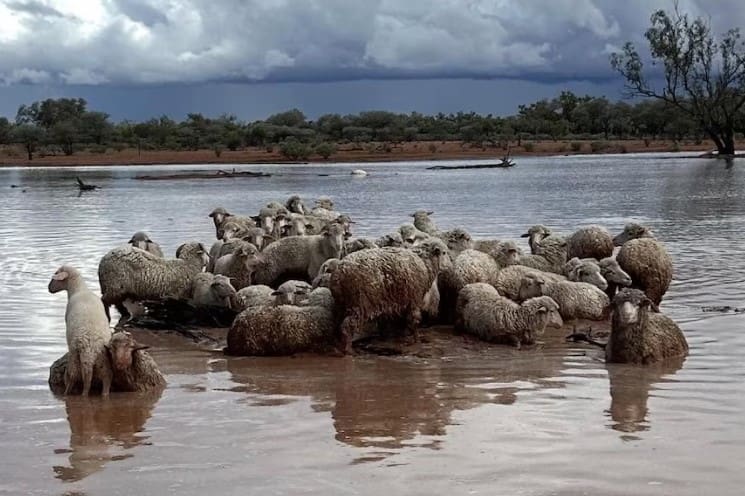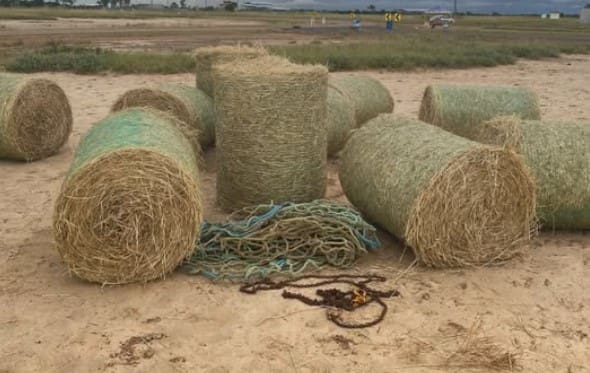
Sheep crowding on a small section of high ground. Supplied – Henry Murray.
MORE than 140,000 livestock were dead or missing in the ongoing outback Queensland floods disaster, with producers expecting final losses to be higher.
The support effort has now turned to ferrying fodder to isolated livestock, with helicopters coming from all directions to help.
The Queensland Department of Primary Industries has been surveying the losses through its website.
Director general Graeme Bolton told a parliamentary inquiry today that 94 surveys had been returned and 144,000 head of livestock were reported missing or deceased.
“That is about 69,000 cattle, 69,000 sheep and 7800 goats and other livestock,” he said.
“Through those surveys, we also know there is about 3500 kilometres of fencing impacted and about 4500 kilometres of local roads.”
Mr Bolton said the department was working with disaster management groups to organise disposal of carcasses and with the Department of Health to make mental health support available.

Hay destined to feed surviving livestock.
Sheep Central has spoken to affected producers who have now turned to focus on co-ordinating feed to their stock on isolated higher ground, but the ongoing rainfall was expected to escalate losses.
AgForce Sheep and Wool Board member Stephen Tully’s property Bunginderry Station is just north-west of Quilpie and received
From an aerial survey of remaining stock, he estimated he had lost about 10 percent of his 800 sheep, plus 500-600 goats and 50 head of cattle. He said the topography of his land had kept his losses lower.
Mr Tully said 20-30 helicopters had come from Alice Springs and Cloncurry and locally to Quilpie to help out.
“The initial few days was identifying where the stock are trapped on islands and on banks.
“They are now doing a lot of hay drops, feeding stranded livestock until the water goes down.”
Mr Tully said shearing was due to start for three months, so most sheep were in full wool, making them more vulnerable to the flood waters.
“It is amazing of the one that are left how tough they are.
“I’ve got sheep that have been standing a strong current belly deep for four days.”
Mr Tully said after the flood waters subside people could plan a holiday into the area and help the economy recover.
He expected the livestock loss figure to dramatically increase with more rain expected and as more landowners were able to survey the damage when flood waters subside.
Eromanga producer Brendan Murray spent three days being dropped behind stranded livestock so he could walk them out to higher ground. He was running 9000 sheep before the flood and has estimated he had lost up to 6000 head, but would not have a final accurate figure for 10 days.
“We think we’ve got 3000 sheep (saved) and a lot of them are ewes.”
He does not know what his cattle losses will be and those left are very week, with surviving stock unlikely to survive further rain. Not many calves have been found and many ewes had lost their lambs.
“We don’t really know.”
Mr Murray said the air support had been amazing.
“I don’t think I would have saved any sheep without Shane and Lauren Wendelborn (of Channel Country Helicopters), I send a big shout out to them – they’ve been enormously helpful.”
Mr Murray said apart from the stock losses, a full year’s income in wool would also be lost with the flood damage to fleeces.
“It’s not going to be the product it was two week ago.”
Mr Murray said the ewes’ lambs never had the liveweight to survive the floodwaters and he estimated any livestock or wildlife under 40kg has been lost.
His neighbour recorded about 450-460mm of rain over three days and another nearby gauge had 390mm.
“We’ve essentially had two years’ rain in four days – we’re in a 250 mm rainfall area.”
Mr Murray said by the time the Bureau of Meteorology had started forecasting the rain, he had already had 50-75mm and was trying to move sheep
“Too late, no warning, too late.”
Queensland premier David Crisafulli in Longreach with agriculture minister Tony Perrett, disaster minister Ann Leahy and local member Sean Dillon today announced flood recovery grants had been increased from $25,000 to $75,000.
A Queensland Department of Primary Industries spokesperson said the department is actively helping producers deal with and recover from the flooding event in western Queensland.
“The impacted area covers approximately 700,000km2, encompassing significant portions of the central west and south-west regions of Queensland.
“This is an area almost equivalent to the entirety of NSW,” the spokesperson said.
“Almost 100 Disaster Impact Surveys had been received by the department as of yesterday afternoon, with the estimated number of missing/deceased stock numbering approximately 145,000 (this includes 69,000 cattle and 67,000 sheep).
“Total fencing damage is estimated at approximately 3500 kilometres, while over 4700km of private roads have been impacted.”
Joint disaster assistance (Commonwealth and Queensland government) includes a $5 million Emergency Fodder Support Package for eligible farmers in Barcoo, Boulia, Bulloo, Diamantina, Longreach, Murweh, Paroo, Quilpie, and Winton local government areas (LGAs).
The Department of Primary Industries has already coordinated the procurement of about 1000 bales of hay for delivery to flood-affected locations.

HAVE YOUR SAY